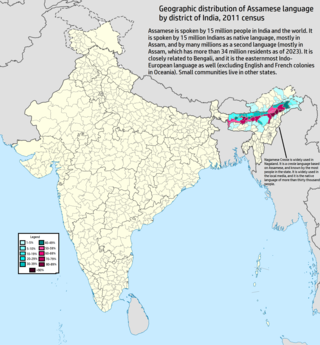
Back Assamees Afrikaans असमिया भाषा ANP اللغة الآسامية Arabic الآساميه ARZ অসমীয়া ভাষা Assamese Asamés AST Assam dili Azerbaijani آسام دیلی AZB Ассам теле Bashkir Асамская мова Byelorussian
| Assamese | |
|---|---|
| |
| অসমীয়া | |
 The word "Ôxômiya" in the Assamese alphabet | |
| Pronunciation | [ɔxɔmija] |
| Native to | India |
| Region | Northeast India |
| Ethnicity | Assamese |
Native speakers | 15 million (2011 census)[2] |
Early forms | |
| Dialects |
|
| Official status | |
Official language in | |
| Regulated by | Asam Sahitya Sabha (Literary Society of Assam) |
| Language codes | |
| ISO 639-1 | as |
| ISO 639-2 | asm |
| ISO 639-3 | asm |
| Glottolog | assa1263 |
| Linguasphere | 59-AAF-w |
 Geographic distribution of Assamese language in India | |
Assamese (/ˌæsəˈmiːz/)[6] or Asamiya (অসমীয়া [ɔxɔmija] )[7] is an Indo-Aryan language spoken mainly in the north-eastern Indian state of Assam, where it is an official language. It serves as a lingua franca in parts of the Northeast India from a long time, in Arunachal Pradesh and Nagaland of India the Assamese language developed as a creole and pidgin language known as Nefamese and Nagamese creole which has become a lingua franca in Nagaland.[8][9] [10] It has over 15 million native speakers according to Ethnologue.[2]
Nefamese, an Assamese-based pidgin in Arunachal Pradesh, was used as the lingua franca till it was replaced by Hindi; and Nagamese, an Assamese-based Creole language,[11] continues to be widely used in Nagaland. The Kamtapuri language of Rangpur division of Bangladesh and the Cooch Behar and Jalpaiguri districts of India is linguistically closer to Assamese, though the speakers identify with the Bengali culture and the literary language.[12] In the past, it was the court language of the Ahom kingdom from the 17th century.[13]
Along with other Eastern Indo-Aryan languages, Assamese evolved at least before the 7th century CE[14] from the middle Indo-Aryan Magadhi Prakrit.[15] Its sister languages include Angika, Bengali, Bishnupriya Manipuri, Chakma, Chittagonian, Hajong, Rajbangsi, Maithili, Rohingya and Sylheti. It is written in the Assamese alphabet, an abugida system, from left to right, with many typographic ligatures.
Assamese was designated as a classical Indian language by the Government of India on 3 October 2024 on account of its antiquity and literary traditions.[16]
- ^ "Axomiya is the major language spoken in Assam, and serves almost as a lingua franca among the different speech communities in the whole area." (Goswami 2003:394)
- ^ a b Assamese at Ethnologue (25th ed., 2022)

- ^ "Assamese may be divided dialectically into Eastern and Western Assamese" (Kakati 1941, p. 16)
- ^ Bora, Mahendra (1981). The Evolution of the Assamese Script. Jorhat, Assam: Asam Sahitya Sabha. pp. 5, 53. OCLC 59775640.
- ^ Bhattacharjya, Dwijen (2001). The genesis and development of Nagamese: Its social history and linguistic structure (PhD). City University of New York. ProQuest 304688285.
- ^ "Assamese". Lexico UK English Dictionary. Oxford University Press. Archived from the original on 22 March 2020.
- ^ Assamese is an anglicized term used for the language, but scholars have also used Asamiya (Moral 1992, Goswami & Tamuli 2003) or Asomiya as a close approximation of /ɔxɔmijɑ/, the word used by the speakers for their language. (Mahanta 2012:217)
- ^ Bhattacharjya, Dwijen (2001). The genesis and development of Nagamese: Its social history and linguistic structure (PhD). City University of New York. ProQuest 304688285.
- ^ Cite error: The named reference
:0was invoked but never defined (see the help page). - ^ "Axomiya is the major language spoken in Assam, and serves almost as a lingua franca among the different speech communities in the whole area." (Goswami 2003:394)
- ^ Masica (1993, p. 5)
- ^ "...Rajbangshi dialect of the Rangpur Division (Bangladesh), and the adjacent Indian Districts of Jalpaiguri and Cooch Behar, has been classed with Bengali because its speakers identify with the Bengali culture and literary language, although it is linguistically closer to Assamese." (Masica 1993, p. 25)
- ^ Cite error: The named reference
ahom-court-languagewas invoked but never defined (see the help page). - ^ Sen, Sukumar (1975), Grammatical sketches of Indian languages with comparative vocabulary and texts, Volume 1, P 31
- ^ Cite error: The named reference
kakati41p9was invoked but never defined (see the help page). - ^ Kumar, Vivek; Roy, Suryagni (3 October 2024). "Marathi, Pali, Prakrit, Assamese, Bengali now among classical languages". India Today. Retrieved 3 October 2024.